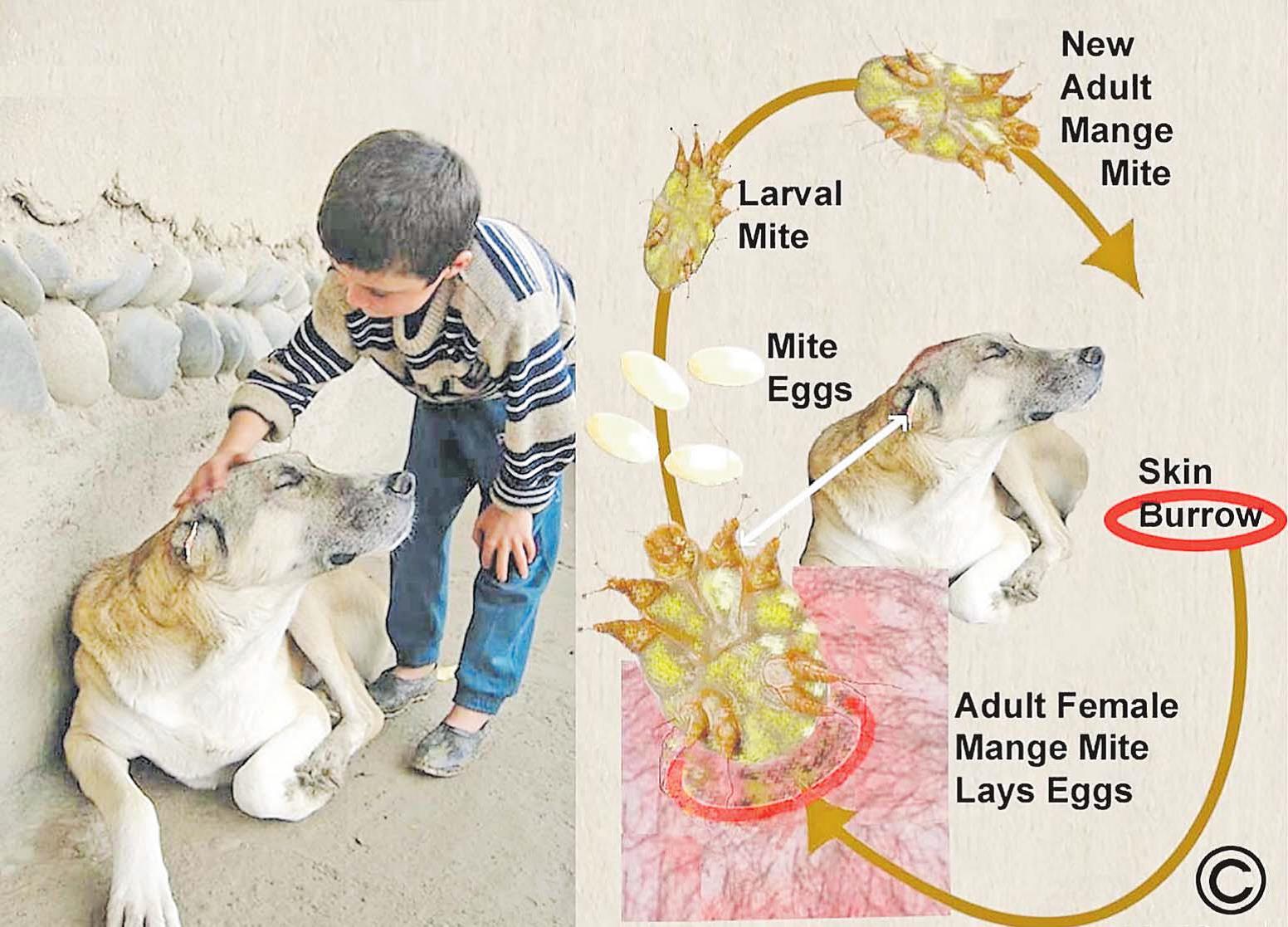Mange is a common term people use for any dog with skin disease, especially the ones with hair loss and itchiness.
However, mange refers to specific skin diseases caused by mites. Mange is caused by different kinds of mites and affects many kinds of animals including humans.
In dogs, there are two major forms of mange, each caused by different mites:
Sarcoptic Mange (also known as scabies);
Demodectic Mange (also known as red mange or demodex); and in cats we commonly find feline scabies caused by Notoedres cati.
Sarcoptic mange
This mange is caused by a circular-shaped, eight-legged mite called the Sarcoptes scabiei. This form of mange is highly contagious.
The parasite can be transmitted from dog to dog and can pass from dogs to humans, although it doesn’t thrive on people.
Female mites burrow into the skin to lay their eggs.
The eggs hatch in about three weeks, and the young feed on the host’s skin.
How is sarcoptic mange diagnosed?
By signs of the disease and a lab test called a skin scrape.
Signs generally appear about 10 days after contact with dog carrying scabies (but can take up to eight weeks).
The first signs of the infection are often on the margins of the ears, chest, lower legs and tummy.
The most common symptoms of sarcoptic mange include: extreme itchiness, red skin, crusty skin, and hair loss; which can quickly spread.
As the disease progresses untreated there will be severe hair loss, thickened skin and thin body condition.
Demodectic mange, or demodex, is caused by a cigar-shaped mite called Demodex canis.
As different from sarcoptes mites, demodex appear to be a normal part of the skin flora, always present, and usually harmless in normally extremely small numbers.
They are passed to pups from their mothers in the first few days after birth.
The mites take up residence deep in hair follicles and stay there usually causing no problems for the dog.
A normal immune system keeps their numbers in check. But in a dog with a weakened immune system (young puppies, older dogs who might be sick or neglected and strays) they can grow out of control.
Young healthy dogs can have patches of demodex which is often spot treated locally with success.
Demodex mites are not contagious to humans.
How is demodectic mange diagnosed Similarly to any mange by signs on the dog and by a microscope exam after a skin scrape.
Symptoms of demodectic mange
In localised cases, it shows up as patches of hair loss and red scaling skin. In generalised cases, the entire body may be covered with redness, infections, scaling, swelling, and crusts. As the disease advances the dog loses most, if not all, hair.
Treatment of mange In dogs
A laboratory test is performed of one or more skin scrapings and a look under a microscope for the presence of eggs or mites.
Sometimes, treatment is started even if no mites appear in the skin samples when the signs strongly suggest an infestation.
Both scabies and demodex will require treatments to kill the mites and heal the skin. Treatments for both forms of mange include several strategies:
Eliminating the mites using topical applications of compounds such as selamectin. Other possible treatments include ivermectin and Simparica.
Some medications kill both types of mites. Length of treatment and time between treatment varies with the product used;
Baths on a weekly basis using medicated or regular shampoo helps heal and soften skin; and
Fish oil supplements help the skin heal.
Mange in cats is commonly caused by tiny mites known as Notoedres cati.
Cat mange causes extreme itching and scratching, discomfort, hair loss, and crusty skin (especially on ear tips).
Other signs to look for include: persistent licking or biting of the skin, patches of hair loss, and skin rashes.
Often the rash appears first on hairless or lightly furred areas because mites prefer these spots, which then spreads with time.
Repeated licking, scratching, and biting can lead to skin infection.
Female mites burrow beneath the skin, causing your cat to continually scratch themselves in an attempt to stop the itching sensation.
Mange spreads quickly in groups of stray cats, because of their unsanitary living conditions. The cat mite has this appearance (diagram above) under the microscope which is diagnosed by a skin scrape in much the same way as skin mites in dogs.
Treatment usually includes prescription medication which kills the mites. In particular, topical (put on the skin) products such as selamectin are a very effective and safe way to treat mite infestations.
Sometimes, antibiotics and/or anti-inflammatory medication are used to treat skin problems and ease inflammation.
- DR JO OLVER is a doctor of veterinary medicine with SPCA Fiji Islands. The views expressed are the author’s and do not reflect the views of this newspaper.



